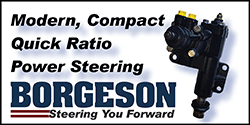That's an idea, I was going to make something that bolted to my exhaust flange.
You are using an out of date browser. It may not display this or other websites correctly.
You should upgrade or use an alternative browser.
You should upgrade or use an alternative browser.
Did I do something wrong?
- Thread starter BHB4408
- Start date
-
The rocker Flexes along with everything else. What specifically am I supposed to ask Jesel?. The rocker can and does flex apart from everything else.
The rocker Flexes along with everything else. What specifically am I supposed to ask Jesel?
Ask them why they don’t build their rockers at the nominal ratio.
It seems to me you think the rockers don’t flex. They do.
PRW fucked up when they built their rockets the first time. The built the rocker with too little ratio built in.
That’s why unloaded they measure 1.64 and loaded they measure 1.58.
They either missed on rocker flex or they missed on pushrod angle.
No rocker, if it’s built correctly will be under nominal ratio when loaded.
Sadly, Chrysler guys have been getting bent for decades because the rockers come in under nominal ratio.
Thankfully Mike at B3 racing engines convinced them they needed to fix the rockers and they did.
The rocker Flexes along with everything else.
I don't know why you think that. Rockers flex along with the rest of the valve train. Increasing the load on the valve end from very light to very stiff can change how much the valve train flexes. Agree?It seems to me you think the rockers don’t flex. They do.
I don't know why you think that. Rockers flex along with the rest of the valve train. Increasing the load on the valve end from very light to very stiff can change how much the valve train flexes. Agree?
No, I do not agree. A flexing pushrod is different from a rocker flexing.
If your pushrods flex at all while turning the engine over by hand your pushrods are garbage.
I say turning the engine over by hand does NOT bend the pushrod and if it does when you stop turning the crank the pushrod goes back to its unloaded state.
If that's not the case the pushrod went into plastic deformation (pretty sure that's the correct term but I haven't studied that in a long time) and it will stay bent.
Where does the load go when you stop turning the engine? If the valvespring is compressed the "valve train" including rockers and pushrods are still loaded.I say turning the engine over by hand does NOT bend the pushrod and if it does when you stop turning the crank the pushrod goes back to its unloaded state.
Where does the load go when you stop turning the engine? If the valvespring is compressed the "valve train" including rockers and pushrods are still loaded.
That's what I'm saying. The pushrod isn't bending turning the engine over by hand. If the pushrods are in a bending load and you stop turning the crank, you'd see the bend.
I'm done trying to explain the simple to you. You can't or won't understand.
Call Jesel. Or T&D. report back.
I'm willing to continue to discuss in a civil way. If you want to opt out that's your choice and I respect that.That's what I'm saying. The pushrod isn't bending turning the engine over by hand. If the pushrods are in a bending load and you stop turning the crank, you'd see the bend.
I'm done trying to explain the simple to you. You can't or won't understand.
Call Jesel. Or T&D. report back.
When you see a difference in lift at the valve between checking springs and race springs you're seeing how much deflection and movement there is in the entire valve train. From the camshaft to the the valve. Individual components all have clearances. There is lubricant between surfaces. Some components will flex and or **** to one side when loaded resulting in lost motion at the valve.
The amount of Lost motion between checking springs and your actual springs can vary depending on a lot of varibles. How soft are the checking springs, how stiff are the springs your going to run, how much clearance is in the individual components, how thick is the lube between the components, how much deflection is in the valve train, how much cocking or seating in the valve train and etc.
Some may not agree with this but I consider the rocker arm ratio to be the distance from the pushrod cup to the contact tip divided by the distance from the pivot to the contact tip. Some may disagree and call the lift at the valve divided by the lobe lift the "rocker arm ratio". I get that. I may even do it myself sometimes. But that might be more accurately called the lobe lift to actual valve lift ratio.
The lobe lift to valve lift ratio takes into account the losses covered earlier in addition to the losses from the geometry involved (that’s another subject). Some engines because of their design will be affected by geometry more than others. Such as pushrod angle.
Why do rocker manufacturers make rocker arms to some amount more than the standard 1.5 or 1.6? My guess ( and it's just a guess) is that it may be for more than one reason. One reason could be to reduce the number of phone calls that involve this conversation: " You made your rocker arms wrong. I just measured my lift at the valve and your 1.5 rocker is only 1.45." Another reason may be that adding some amount of ratio can be used to offset deflection, geometry and etc. to make the theoretical valve lift found on cam cards more closely match the actual valve lift seen at the valve. This might be helpful for some when comparing cams.
This is why in my opinion, when you see a difference in lift at the valve between a checking spring and a race spring it is not caused by a change in the rocker arm ratio. Others my disagree and I respect that.
Out of respect for the people at Jesel or T&D I'm not going to call them with a "hey, we're having a discussion on a forum" question. Especially not in March. If I get the chance and they don't look to busy at their booth I may bring it up in December at PRI.
The amount of Lost motion between checking springs and your actual springs can vary depending on a lot of varibles. How soft are the checking springs, how stiff are the springs your going to run, how much clearance is in the individual components, how thick is the lube between the components, how much deflection is in the valve train, how much cocking or seating in the valve train and etc.
Some may not agree with this but I consider the rocker arm ratio to be the distance from the pushrod cup to the contact tip divided by the distance from the pivot to the contact tip. Some may disagree and call the lift at the valve divided by the lobe lift the "rocker arm ratio". I get that. I may even do it myself sometimes. But that might be more accurately called the lobe lift to actual valve lift ratio.
The lobe lift to valve lift ratio takes into account the losses covered earlier in addition to the losses from the geometry involved (that’s another subject). Some engines because of their design will be affected by geometry more than others. Such as pushrod angle.
Why do rocker manufacturers make rocker arms to some amount more than the standard 1.5 or 1.6? My guess ( and it's just a guess) is that it may be for more than one reason. One reason could be to reduce the number of phone calls that involve this conversation: " You made your rocker arms wrong. I just measured my lift at the valve and your 1.5 rocker is only 1.45." Another reason may be that adding some amount of ratio can be used to offset deflection, geometry and etc. to make the theoretical valve lift found on cam cards more closely match the actual valve lift seen at the valve. This might be helpful for some when comparing cams.
This is why in my opinion, when you see a difference in lift at the valve between a checking spring and a race spring it is not caused by a change in the rocker arm ratio. Others my disagree and I respect that.
Out of respect for the people at Jesel or T&D I'm not going to call them with a "hey, we're having a discussion on a forum" question. Especially not in March. If I get the chance and they don't look to busy at their booth I may bring it up in December at PRI.
Last edited:
When you see a difference in lift at the valve between checking springs and race springs you're seeing how much deflection and movement there is in the entire valve train. From the camshaft to the the valve. Individual components all have clearances. There is lubricant between surfaces. Some components will flex and or **** to one side when loaded resulting in lost motion at the valve.
The amount of Lost motion between checking springs and your actual springs can vary depending on a lot of varibles. How soft are the checking springs, how stiff are the springs your going to run, how much clearance is in the individual components, how thick is the lube between the components, how much deflection is in the valve train, how much cocking or seating in the valve train and etc.
Some may not agree with this but I consider the rocker arm ratio to be the distance from the pushrod cup to the contact tip divided by the distance from the pivot to the contact tip. Some may disagree and call the lift at the valve divided by the lobe lift the "rocker arm ratio". I get that. I may even do it myself sometimes. But that might be more accurately called the lobe lift to actual valve lift ratio.
The lobe lift to valve lift ratio takes into account the losses covered earlier in addition to the losses from the geometry involved (that’s another subject). Some engines because of their design will be affected by geometry more than others. Such as pushrod angle.
Why do rocker manufacturers make rocker arms to some amount more than the standard 1.5 or 1.6? My guess ( and it's just a guess) is that it may be for more than one reason. One reason could be to reduce the number of phone calls that involve this conversation: " You made your rocker arms wrong. I just measured my lift at the valve and your 1.5 rocker is only 1.45." Another reason may be that adding some amount of ratio can be used to offset deflection, geometry and etc. to make the theoretical valve lift found on cam cards more closely match the actual valve lift seen at the valve. This might be helpful for some when comparing cams.
This is why in my opinion, when you see a difference in lift at the valve between a checking spring and a race spring it is not caused by a change in the rocker arm ratio. Others my disagree and I respect that.
Out of respect for the people at Jesel or T&D I'm not going to call them with a "hey, we're having a discussion on a forum" question. Especially not in March. If I get the chance and they don't look to busy at their booth I may bring it up in December at PRI.
When you see a difference in lift at the valve between checking springs and race springs you're seeing how much deflection and movement there is in the entire valve train. From the camshaft to the the valve. Individual components all have clearances. There is lubricant between surfaces. Some components will flex and or **** to one side when loaded resulting in lost motion at the valve.
The amount of Lost motion between checking springs and your actual springs can vary depending on a lot of varibles. How soft are the checking springs, how stiff are the springs your going to run, how much clearance is in the individual components, how thick is the lube between the components, how much deflection is in the valve train, how much cocking or seating in the valve train and etc.
Some may not agree with this but I consider the rocker arm ratio to be the distance from the pushrod cup to the contact tip divided by the distance from the pivot to the contact tip. Some may disagree and call the lift at the valve divided by the lobe lift the "rocker arm ratio". I get that. I may even do it myself sometimes. But that might be more accurately called the lobe lift to actual valve lift ratio.
The lobe lift to valve lift ratio takes into account the losses covered earlier in addition to the losses from the geometry involved (that’s another subject). Some engines because of their design will be affected by geometry more than others. Such as pushrod angle.
Why do rocker manufacturers make rocker arms to some amount more than the standard 1.5 or 1.6? My guess ( and it's just a guess) is that it may be for more than one reason. One reason could be to reduce the number of phone calls that involve this conversation: " You made your rocker arms wrong. I just measured my lift at the valve and your 1.5 rocker is only 1.45." Another reason may be that adding some amount of ratio can be used to offset deflection, geometry and etc. to make the theoretical valve lift found on cam cards more closely match the actual valve lift seen at the valve. This might be helpful for some when comparing cams.
This is why in my opinion, when you see a difference in lift at the valve between a checking spring and a race spring it is not caused by a change in the rocker arm ratio. Others my disagree and I respect that.
Out of respect for the people at Jesel or T&D I'm not going to call them with a "hey, we're having a discussion on a forum" question. Especially not in March. If I get the chance and they don't look to busy at their booth I may bring it up in December at PRI.
Like I said, your opinion is wrong.
Jesel says it.
T&D says it.
Norris said it.
If Jesel is so busy they can’t take a call I’d be surprised.
I’d do it but you’d keep arguing.
Like I said, you are married to your opinion. But the fact is no one, and that is NO ONE makes a rocker at its nominal ratio.
Why? Because the rockers FLEX.
-Boosted-
Hard Member
I got the perfect t-shirt for you.... lolThat's what I'm saying. The pushrod isn't bending turning the engine over by hand. If the pushrods are in a bending load and you stop turning the crank, you'd see the bend.
I'm done trying to explain the simple to you. You can't or won't understand.
Call Jesel. Or T&D. report back.
Exactly. I got in the phone in the late 1980’s about this.
I don’t just pull **** out of my *** so I can thrust and parry on a forum
Add Crane to that list because the first guy I talked to about this very thing was Chase Knight at Crane.
It’s like damn, the rockers flex.
Well, that is funny. Of course I don't think that applies to me but it is funny.
Well, that is funny. Of course I don't think that applies to me but it is funny.
On that we agree.It’s like damn, the rockers flex
-
Similar threads
- Replies
- 21
- Views
- 3K
- Replies
- 97
- Views
- 12K
- Replies
- 7
- Views
- 1K
- Replies
- 8
- Views
- 499
















